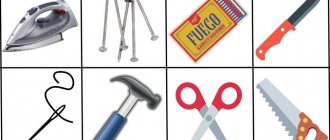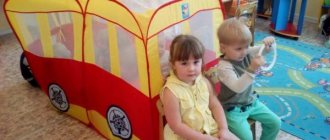Progress of the game:
Children are given large cards with images of wild and domestic animals and birds. The teacher shows small cards with pictures of cubs and tells who is depicted on them, and in a playful way teaches how to match small cards to large ones . Possible options : the method of matching animals to each other or finding the corresponding animals according to the description.
AQUARIUM
didactic game for the development of a holistic perception of the subject
Target:
• Form a holistic image of an object and activate ideas about objects.
• Develop attention and imagination.
• Learn to pay attention to the spatial arrangement of parts and their correspondence with other parts of the whole.
• Develop flexion and extension movements of the hands children
• Create an emotionally positive attitude towards completing the task and the result of your actions.
Equipment:
On a thick sheet of cardboard there is a plot picture “Aquarium”
.
In the story picture, pieces of Velcro are attached under the fish, as well as on the back of the fish, so the fish in the aquarium have the property of tabs.
Each fish has small rings for easier movement. Progress of the game: (conducted individually with each child)
First, the child looks at the whole
picture “Aquarium”
, filled with tabs - fish, and, if
possible, names the depicted objects and the situation, or shows certain objects at the request of the teacher.
Then the teacher removes, holding the ring of the tabs - fish, mixes them and asks the child to insert the tabs - fish into their places. If a child makes mistakes when inserting fish, then the teacher points to the outline of the fish and shows the outline and the image of the fish in comparison. Throughout the game, the teacher pays attention to the correct holding of the fish by the ring and their correct placement in the aquarium using Velcro. BOWS
didactic game for practicing practical skills and
development of manual motor skills
Target:
• Development of fine motor skills of hands and fingers.
• Teach children to tie bows or ribbons.
• Learn to distinguish colors and focus on color as a significant feature.
• Form the concepts of “long - short”
Equipment:
Vertical sheet of hardboard fixed to the wall for more convenient use; bows or ribbons of various colors and sizes, attached to a sheet of hardboard.
Progress of the game:
The teacher lays out a frame-liner in front of the child and shows geometric shapes, draws attention to the color, shape and various combinations of collecting these geometric shapes. The teacher explains that to make folding the figures more convenient, you need to hold on to the holder attached to each figure. First, the teacher gives the child figures for only one geometric figure and asks them to guess how they can be used to form a whole figure. Encourages him to try and try things on. In the future, you can give all the material, but if you have difficulties, go back to a limited number of images.
POLYANKA
didactic game for the development of a holistic perception of the subject
Target:
• Form a holistic image of an object and activate ideas about objects.
• Develop attention and imagination.
• Learn to pay attention to the spatial arrangement of parts and their relationship with other parts of the whole.
• Teach color discrimination by selecting the same colors by eye and then checking.
• Develop flexion and extension movements of the hands children
• Create an emotionally positive attitude towards completing the task and the result of your actions.
Equipment:
On a thick sheet there are two working zones: on the larger one - a background for drawing up a plot and small pieces of Velcro of different colors attached to it, but corresponding to the colors of the Velcro on the back of the figures (sun, clouds, butterflies, located in the second small zone, also attached with Velcro The number of Velcro on both working areas is equal. Each figure has a small ring to make it more convenient to move the figure on the Velcro.
Progress of the game: First, the child looks at the whole picture , filled with attached figures, if possible , names the depicted objects and the situation, or shows certain objects at the request of the teacher. Then the adult removes several figures and asks the child to place them in the appropriate places. If the child makes mistakes when moving, the teacher points to the back of the figures and shows the corresponding color of Velcro on which the figure should be placed.
ASSEMBLE A HOUSE
corrective exercise for practical highlighting of the form
Target:
• Learn to correlate planar and volumetric forms in practical action with objects.
• Learn to use the trial method, discarding erroneous options and fixing the correct ones.
• Learn to see the shape in an object, to correlate the shape of the slot and the inlay.
Equipment:
Two plastic boards (each with 6 slots)
in the form of houses; plastic figures of various colors, shaped to match the slots.
Progress of the game:
The teacher takes his sheet of cardboard and shows (or other animals) walks on the grass.
.
“Oh, it’s raining
,” he says, turns the sheet over and shows the children how to stretch the braid to make rain.
At the same time, he draws attention to the fact that the rain comes from top to bottom diagonally - and each braid is pulled into its own slots, they are all laid side by side. Then the teacher gives the children sheets of cardboard , and they use it to complete the task. After this, the teacher turns the sheet over and says: “It’s raining again, quickly hide your bunnies (or other animals)
.”
Hands out figurines of bunnies (or other animals)
. Children hide them under mushrooms.
PYRAMID
corrective exercise for the development of related actions
Target:
• Learn to correlate the holes of the rings with the rod.
• Develop visual-motor coordination when operating with both hands.
• Form direction of action and stability of attention.
• Activate ideas about color, consolidate the names of colors.
Equipment: Pyramids of different sizes and shapes.
Progress of the game:
The teacher shows the children a box of semolina and explains that in addition to pencils, paints, and felt-tip pens, you can draw various figures, objects and images with your fingers. The teacher shows how to draw and how to easily erase the drawing. The work is carried out individually, while drawing from a model, joint drawing, and free creativity are possible
MY FRIEND, CHICKEN
correctional game to develop the ability to communicate with others
Target:
• Development of kinesthetic sensations.
• Developing the ability to cooperate with adults and come into contact with them.
• Learn to overcome disgust (to paints)
Equipment: Colored paints with a brush, toy chickens.
Progress of the exercise:
The teacher invites the children to play the game “Fun Pencil”
and with its help, complete the drawing of objects, outline drawings, letters, shade images of various objects, etc.
TETRIS
correctional exercise for the development of logical thinking
Target:
• Learn to correlate planar figures with a model and in practical action with objects.
• Learn to use the trial method, discarding erroneous options and fixing the correct ones.
• Develop logical thinking by putting figures in a certain order and in specially designated tabs.
Equipment:
Frame – liner with six windows; geometric shapes of rectangular and square shapes of various sizes and colors.
Progress of the game:
The teacher shows and talks about the purpose of each household item. Teaches how to use them, practices skills, gives clear instructions: “Turn off the lights.”
;
“Turn off the iron”
;
“Close the window”
, etc.
CIRCLE, COMPLETE, SHAD
corrective exercise to prepare your hand for writing
Target:
• Learn to perceive an object using a circling movement and use the resulting image in artistic activity.
• Learn to complete the drawing, creating an image.
• Development of fine motor skills of the hand.
• To form purposeful activity and perseverance in work.
Equipment: Sets of cards with unfinished objects, with the task of drawing horizontal lines, completing the drawing and tracing it along the contour, etc.
Progress of the game:
The teacher invites children to learn how to tie bows or ribbons, shows how to do this, and gives each child a try. The game is played in stages until the child learns to first tie at the base, then fold a bow or ribbon in both hands and then only make the main knot.
LET'S DRESS A TOUCHED DOLL
didactic game for the development of manual motor skills
Target:
• Learn to thread a lace into a hole, first by imitation, then by model.
• Develop small movements, purposefulness of actions.
• Observe the direction of movement diagonally, horizontally (despite the discontinuity of the line)
.
• Form visual-motor coordination and spatial orientation.
• Create an emotionally positive attitude towards the game task.
Equipment:
A cardboard sheet with an image and in the shape of a doll - a tumbler, holes are made on the head of the tumbler and a blue cord is attached; Holes are made on the apron and skirt of the tumbler doll and red and green laces are attached to them.
Progress of the game:
The teacher shows a figurine of a tumbler doll, examines it with the children, and draws attention to individual parts of clothing: a scarf, a skirt and an apron. The teacher asks the children to help dress a tumbler doll. The teacher explains how to do this, threads the tip of the lace into the hole and laces the scarf, skirt, and apron separately. Children perform this task according to a model, by imitation, independently and according to verbal instructions.
DECORATE DOLL
didactic game for practicing practical actions
Target:
•Practice practical actions with objects: ribbons, hairpins, Velcro, buttons.
• Learn to correlate objects depending on their correct location.
• Learn to evaluate your actions and enjoy positive results.
• Develop fine motor skills.
Equipment:
A doll made from a plastic bottle; "wardrobe"
dolls - a skirt made of ribbons attached to the belt with Velcro and buttons, hairpins of various colors and shapes, ties - elastic bands for braids, bows.
Progress of the game:
The teacher shows the child the chickens, says that they came to visit them and want to be treated to grains. Since the chickens are very small, they are used to pecking grains from the palm, and the teacher suggests painting the grains on the palm and feeding the chickens. During the game, the teacher encourages and praises the child.
ZIPPER "
exercise to develop self-care skills
Target:
• Teach children how to fasten zippers.
• Development of manual skills.
• Developing self-care skills.
• Develop flexion and extension movements of the hands children
• Develop purposefulness of actions.
• Learn to distinguish colors, focus in the exercise on color as a significant feature.
Equipment: A thick sheet of cardboard is covered with fabric and has zippers sewn on it - zippers in different directions and different colors, sizes (long, short, wide and narrow, quality (iron or plastic)
Progress of the game:
The teacher shows the figure of a butterfly, examines it with the children, paying attention to individual parts: the head, wings of different sizes, the body, explains that the head is located on top, the body is under the head, the wings are on the sides. Then the teacher shows how to make the same butterfly, composing it from separate parts. First, he places all the parts correctly on the table, then fastens all the buttons, connecting all the parts together so that they do not fall apart. The teacher invites the children to make exactly the same butterfly, handing out a set of parts. Children gradually lay out the parts, making them into a whole under the supervision of an adult, then fasten the buttons. Then the children can play with the butterflies.
FIND YOUR MOTHER CHILDREN
didactic game for the development of auditory perception
Target:
• Expand and clarify the meanings of words - names of animals and words related to the way of life of animals.
• Learn to match baby animals with adult animals by description or selection method.
• Learn to identify animals based on the teacher’s story.
Equipment: Large cards with images of wild and domestic animals, birds: cows, foxes, horses, chickens, etc.; small cards depicting the young of these animals .



